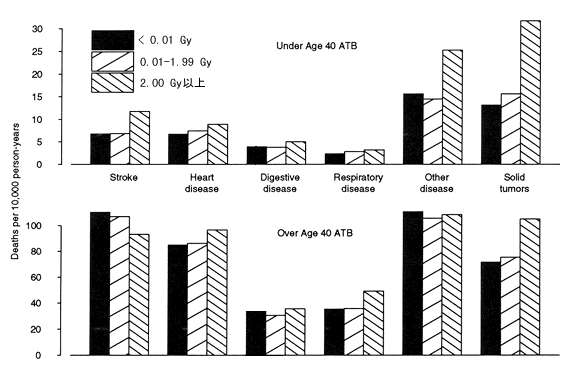Death Rates for Selected Causes by Dose and Age at Exposure
This article was originally published in RERF Update 3(2):10, 1991.
Three articles in this issue of RERF Update deal with recent work on noncancer mortality in the RERF Life Span Study (LSS). The Figure below summarizes death rates in the LSS for selected causes averaged over the period from 1950 through 1989.
Death rates are based on 86,572 LSS members, who were in Hiroshima or Nagasaki at the time of the bombings (ATB). The under 40 age-ATB population includes 58,586 persons with an average follow-up of 35 years per person. The over 40 age-ATB population includes 27,982 persons with an average follow-up of 20 years per person. Of the LSS members included in this analysis, 41% (18% of those who were under age 40 ATB and 89% of those over age 40 ATB), or 35,289 persons, died during the period from 1950 through 1989.
For each disease category, crude rates are given for three DS86 kerma groups: <0.01 Gy, 0.01-1.99 Gy and >2.00 Gy. The last group consists of only a little more than 1% of the total person-years (about 28,000 person-years for those under age 40 ATB and about 5,900 for those over age 40 ATB). For the lower dose categories, the person-year totals are about equal.
The disease category “other” includes all the noncancer cases other than stroke, heart, digestive, and respiratory diseases. Death rates due to leukemia have been omitted.
In looking at these figures, it is important to note the difference in scale for the two age-ATB groups.


